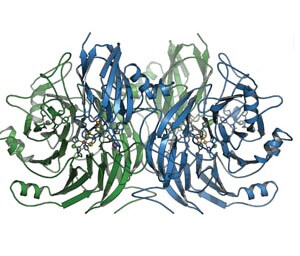Nitric oxide (N2O) is a greenhouse gas 300 times stronger than carbon monoxide and also damages the ozone layer, so it is important to neutralize it

The enzyme nitric oxide reductase, a biochemical catalyst that contains the metal copper, plays a key role in biochemical processes, while it recycles nitric oxide, which is a greenhouse gas, into normal nitrogen. Now, a team of researchers from Germany has shown that the active site contains another atom, sulfur, which was unknown to researchers in this field until now.
Nitrogen oxide (N2O) is harmful to the Earth's climate in two ways: first, this oxide is a colorless and odorless greenhouse gas that is 300 times more active than another greenhouse gas - carbon dioxide. Second, due to the effect of cosmic radiation, this gas contributes to the destruction of the ozone layer, similar to halogen-containing hydrocarbons, such as air conditioner gases.
In light of this, nitric oxide is probably the most influential greenhouse gas in the twenty-first century and is an unwanted byproduct of the agricultural industry. The enzyme nitric oxide reductase, a biochemical catalyst that contains the metal copper, serves a key role in biochemical processes, while it recycles nitric oxide to normal nitrogen.
The functions and mechanisms of activity of this important enzyme have not been studied in depth until today, when Dr. Anja Pomowsk, from the Department of Organic Chemistry and Biochemistry at the University of Freiburg in Germany, was able to successfully decipher the structure of the enzyme. The research findings were published in the prestigious journal Nature.
The newly deciphered structure shows, firstly, that the ratio and quantity of the components in the metal core of the enzyme have been incompletely described so far and that they contain an additional sulfur atom. Second, the research team also discovered the binding site of the nitric oxide to the metal core. This site was an unexpected surprise for the researchers, and served as a finding that encouraged the researchers to re-examine the mechanisms of the enzyme's activity and further investigate its molecular properties.
The news about the study

4 תגובות
It says N20 is nitrogen dioxide - the greenhouse gas itself and not the enzyme that breaks it down, at least according to the site from which I took the picture
It is indeed an enzyme.. It's unpleasant to comment, but a little attention from some editor wouldn't hurt.
Apparently the enzyme appears in the picture.
The molecule shown in the picture is not N2O. It looks like protein